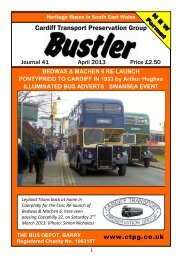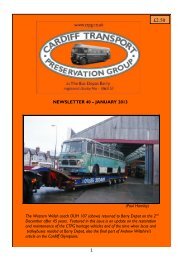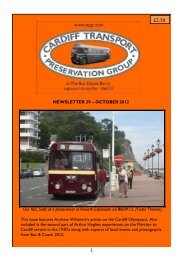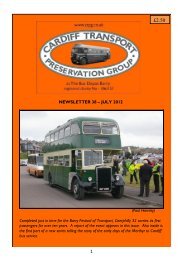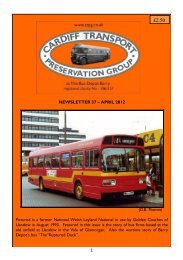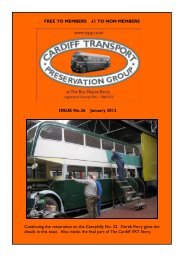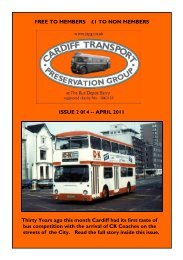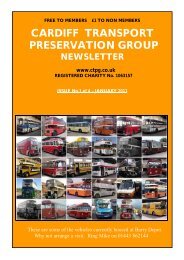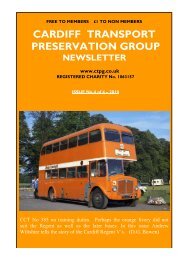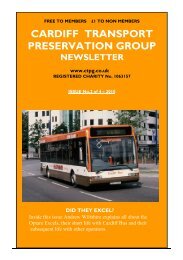CTPG News Summer 2002
Create successful ePaper yourself
Turn your PDF publications into a flip-book with our unique Google optimized e-Paper software.
CARDIFF
TRANSPORT
PRESERVATION
CROUP
CTPG
NEWS
Centenary Edition Summer 2002
Registered charity no: 1063157
Please send correspondence to:
D.G. Bowen
12 Carlton Terrace
Troedyrhiw
Merthyr Tydfil CF48 4EP
Tel: 01443 693087
Fax: 01443 693696
Email: d.bowen(@.surfanvtune.co.i]k
Cover Photo: Cardiff Crossley DD42/7 No. 42
Courtesy of R Marshall collection
Chairman - Giyn Bowen
Vice Chairman - Martin Doe
Treasurer - Paul Hamley
Newsletter Editor - Stephen Morgan
Articles and views expressed in this newsletter are not necessarily
those of the editor, or the Cardiff Transport Preservation Group.
THE EDITORIAL by Steve Morgan
Welcome to the centenary edition of CTPG News. In the
time since the last edition, the group has experienced mixed
fortunes. Our monthly meetings have been very successful
with pleasing attendances. We had a quiz night, another
excellent sHde show, and most recently a talk on the Bruce
coach works,(see the Chairman's column for a report on this)
which coincided with the launch of our first pubhcation, "A
brief history of Bruce Coachworks". The production of this
book was wholly funded by the "Awards for Wales", and all
proceeds will go to restore and maintain C.T.P.G vehicles. If
you would like a copy, do not delay, as a limited production
run of only 500 have been produced.
Sadly, the hoped for appearance of the groups Cardiff
AEC Swift No.512 at the centenary did not materiahse, yet
another missed debut for this bus! Although the 505 engine
has been rebuilt by Cardiff Bus the company were imable to
fit it due to other commitments.
The continuing storage problems are an ongoing
headache, Barry depot is still possibly on the cards, but
only as a storage facility, work on the vehicles wovild not be
permitted.
Sadly a recent vandal attack has left our FleetUne, 532,
along with most of the other vehicles with a number of
smashed windows. If you have any ideas or information on
possible safe, secure (and cheap) garaging for our buses, it
would be most welcome.
I hope you enjoy this edition, and invite you to come
along to our monthly meetings. The next one is at Cardiff
County Hall on Wednesday, July 17th at 7:30, non members
welcome.
CHAIRMAN'S MESSAGE
For a number of reasons our planned regular "CTPG News" has not proved as regular as
intended and this is the third Chairman's Message I have written for this edition such is
the way things keep changing at present.
Publication of this edition is planned to coincide with "Bus & Coach Wales 2002" in
Cardiff on the 7* July so by the time you read this it will probably all be over! The event
this year was, of course, dominated by the Cardiff Bus Centenary and we are particularly
pleased to be associated with Cardiff Bus during this period.
The safe storage of the vehicles remains our major problem. In the last edition I indicated
that removal of the vehicles fromthe former Western Welsh Barry Depot was imminent
but, in the event, this did not happen although later in the year the vehicles belonging to
the Trolleybus Project were relocated to a site at Wentloog just outside Cardiff. A
meeting was held in December that seemed to lay the basis of an agreement with the Vale
of Glamorgan Council for the rental of part of the building for the storage of vehicles.
Over six months later we have only just received a draft of the proposed licence to use
the premises. During the interim period we have not been allowed to access the premises
and vandals have caused damage to the vehicles stored there. Even if agreement is
eventually reached, we still need a site where work can be carried out on the buses.
At the time of writing (21"* June) we still occupy the warehouse at Newport but we are
under notice to vacate the premises as work has now commenced on the new road
scheme. , ,
Until adequate premises can be obtained, progress on the restoration of our vehicles is
painfully slow. Mention was made in the last edition that Cardiff Bus was to carry out
work on AEC Swift 512. Unfortunately, Cardiff Bus was unable to complete the job but
the engine has been fiiUy overhauled and rebuilt and now awaits reinstallation. Any
practical suggestions on how this can be accomplished are welcome. It was a great
disappointment that this bus was not available for the centenary celebrations.
Although not a CTPG vehicle, we are pleased that Cardiff Bus carried out some work on
the Cardiff Regent V Group's vehicle (fleet no. 408) including a full repaint and
restoration of the original destination display layout. This vehicle is a fine example of
what this Group should be achieving.
On a more positive note, we have now held monthly meetings for over a year and
attendances average around 25 to 30 members and friends with even more at certain
meetings. The £1 collected from each person attending is a welcome boost to our
finances. One difficulty, however, is finding ten speakers each year without too much
repetition - any volunteers?
A notable achievement has been the production and pubUshing of our first book detailing
the story of Air Dispatch Ltd and Bruce Coach Works Ltd of Cardiff. As this was
completely iiinded by the Heritage Lottery Fund through the "Awards for All Wales"
scheme, every copy sold yields a 100% profit for the Group. Other sales items also
funded by the same source are imder preparation. The launch of the book at our June
meeting was a particularly successfiil event attended by 40 members and guests including
Carey Chapman who gave a short talk on the life of Mrs Mildred Bruce, John Horn
(Sales Manager of East Lancashire Coachbuilders Ltd) who spoke briefly about East
Lanes and Ken Bowring a former Bruce Coach Works employee. Sales of the book, a
raffle, room fees and sale of photographs donated by Denis Chick boosted Group fimds
by over £270.
It is our intention that extra copies of this edition will be printed for sale at the Rally so
hopefully many of our readers will be non-members who we hope will eventually decide
to join us. Please feel fi-ee to come along to our next meeting at the Cardiff County Hall,
Atlantic Wharf, Cardiff at 7.30pm on Wednesday 17* July 2002. This meeting will
review the Rally and discuss the future of the Group and its vehicles. Following that, our
next meetings are on 21** August and 18* September. At the September meeting our
speaker will be David Smith, former General Manager of City of Cardiff Transport.
At the request of members, 1 append below a list of the current membership. It is
particularly pleasing to note that a number of former Cardiff Transport employees have >
joined us during the last few months and a warm welcome is extended to them and all
new members.
_
Glyn Bowen
Chairman
2002 Members
*Glyn Bowen
*Lewis Burrell
*Martin Doe
*Brian Francis
•Frank Hart
*Richard Johnson
•John Kirk
Gordon Mills
•Desmond O'Sullivan
Clive Sampson
•Chris Taylor
•Andrew Wiltsliire
Tony Brewer
Denis Chick
•Alun Emlyn-Jones
•John Griffiths
Barry Hodges
Bob Jones
•Ken R Leonard
•Stephen Morgan
•William Price
•Peter Smith
•Mike Taylor
•Tim Wore!
•JuUan Brinkworth
Roger Davies
•Martyn Evans
•Paul Hamley
•Malcohn Howitt
•Trevor Jones
•Ken G Leonard
•AUan Morse
•Phil Rixon
•Mike Street
Philip Vine
Members marked • are resident in Cardiff or South East Wales.
The Cardiff Bus Centenary, 1902 to 2002
CardiflPs Municipal Transport History commenced on 1^ January 1902 when the
Cardiff County Borough purchased the lines, 52 horse drawn tramcars and 342
horses of the Cardiff Tramways Company. A programme of electrifying the tramway
system commenced almost immediately enabling the last horse drawn trams to
be withdrawn from the Council's routes in October the same year. By 1905, when
Cardiff became a City, 131 electric trams were at work.
^
The imt motorbuscs owned by the Cardiff City ('ouncii commenced nmnmg on
24th December 1920 alongside the many small private operators also providing
services at that time. Over the ensuing few years, motorbus services were rapidly
expanded both within and outside the City boundaries. A service to Newport started
in 1924 and one to CaerphiUy in 1929. By 1928 the Council had built up one of the
largest municipally owned bus fleets in Great Britain.
Trolleybuses were introduced on the 1* March 1942 and, as further deliveries of
this type of vehicle were received after the war, the tram routes were gradually
withdrawn and mostly converted to trolleybus operation. Cardiff s last trams ran on
the Gabalfa service in February 1950. Further expansion of the trolleybus system
took place in 1955 when services to Green Farm Road, Ely via Grand Avenue were
introduced. . .
In 1961 the decision was taken to phase out the trolleybuses over a period often
years. The last normal services trolleybuses ran in December 1969 but a limited
special service was operated early in January 1970 to mark the official closure of
the system - incidentally the last in Great Britain to use three axle trolleybuses.
Since the withdrawal of the trolleybuses, motorbuses have reigned supreme. Over
a period of a few years the entire fleet became one-person-operated and in 1972 the
old crimson lake and cream livery gave way to a new orange and white livery
iotended to convey a more modem image.
The 1985 Transport Act introduced deregulation of bus services and also required
local authorities to set up "arms length" companies to run their buses. Cardiff set up
Cardiff City Transport Services Ltd., which now trades as "Cardiff Bus". In 1999
the livery changed again - this time to Surges blue and cream - in line with the
Councils corporate scheme and emphasises tlie Unk between the two organisations
just as the crimson lake and cream did for nearly 70 years.
Cardiff Bus - Fleet Update
Another large batch of Dennis Darts entered service dtiring
April. This coincided with major route and timetable changes
in the north and west of the city. The new vehicles completely
replaced the F reg mk.l Leyland Lynxes 231 - 236 and 241 - 248
(237 - 240, the 5-speed dual purpose batch were sold over a year
ago). Of the G reg mk-l's 249 and 256 were also withdrawn,
leaving just nine mk.l is left m service. More receiitly, the total
in passenger use has dropped to just six examples (250 - 255) as
257 -259 have been transferred to the training school, and have
replaced the last three Leyland Olympians. Longs of Abercraf
have purchased 509, 512 and 566 for recertification as PCV's
once more. Fvirther Volvo Ailsas have been withdrawn, leaving
an operational double deck fleet of 28 vehicles,and at the time
of writing only two former Merseybus examples remain in
service.
238 one of the now wthdrawn Mkl Freg Lynx seen at Penylan terminus.
CARDIFF BUS CLOCKS 55 YEARS m PRESERVATION
In the firstedition of "CTPG
submitted
News"
by
the
Glyn
editor
Bowen
included a list of surviving vehicle
fi-om themaroon and cream era. The list reveals that, as far as is known, the
Cardiff Corporation motorbus still in, existence is- the 1949 Crossley DD42/7
registered EBO 900, fleet number 46. With this the Cardiff centenary year, it
seems appropriate to put on record some details concerning the preservation of
bus that has now clocked up 17 years in service and 35 years in preservation!
In 1966 four local bus enthusiasts - Robert Milfbrd^ Lyndon Rees, John Woodwa
and myself - formed the "Cardiff 46 Group" with the aim of acquiring the last of
Cardiff Crossleys for preservation. Bu& preservation was still quite a new hobby
especially in South Wales ahhough a number of commercial vehicles were preserve
in the area and their owners provided some much welcomed advice and assist^
The City Council were asked to donate the vehicle and, ahhough this was declin
offered to sell 46 at the average price obtained for the other fivevehicles in. the ba
As some had been stripped for spares before sale, the average worked out at £60
£12 for the slave tyres. Not a bad deal as the bus was serviced at Slopec Road d
its last few days in service and somehow had a full tank of fiiel.
46's first new home was alongside a bam an a farm in Cowbridge covered with
large tarpaulin and much of the early restoration work was carried out ihere. I w
remember many hours on an hot aluminium roof chipping off many layers of ve
hard paint! Over the years 46 had many temporary homes - with caravans in an
hanger at RAF St. Athaiv surrounded by toilet rolls in a hanger at Llandow come
mind. Work continued steadily, starting with the inside as we knew it would b£
difficult to move on to the inside if the exterior restoration, was completed &is
travelled to Stockport and collected a pair of brand new front wings - I believe w
paid £5 each. I had an Austin 1100 and the wings weretiedonthe roof rack!
Cardiff Corporation Transport alowed us the use of the paint shop at Roath Dep
over a couple of weekends and Robert made a superb job of the repaint fbliowiag
advice readily given by the coachpainters at Roath, one of whom helped with th
black lining. During and afler resboratioiL.46 appeared at various ralles includiog th
HCVS 10* Birthday Rally at Bealieu, the Bus of Yearyear Rally at Stratford, severa
visits to the Weymouth and Bristol events and various, local rallies and carnivals.
Problems over garaging and the changed circumstances of the owners led, in 1977
the decision to pass ownership to the National Museum oLWales for. display at
Welsh Industrial and Maritime Museum in Cardiff. It was initially housed in the
Vehicle Shed along with Cardiff trolleybus 215 and opentop Guy Arab 434 but,
later years, was parked outside with little or no protection. When the museum clos
the three ex Cardiff vehicles were transferred to the former Western Welsh depot
Barry and left to suffer the ravages of time.
Cardiff Corporation 1949 Crossley DD42/7 EBO 900, fleet number 46.
LW>EKSM*BMSE Sf/XCJS)mHiE S
Since the dawn of the new millenium rumors have been
rife that the island of Malta was to have its complete
508-8trong service bus fleet replaced by new low-floor singledeckers
built to Euro 2/Euro 3 specification. Indeed magazine
articles suggested that the Chinese had secured a deal
to supply around 500 "King Long" low-floor single deckers
fitted with Cummins C220 Turbo Diesel Engines(Euro 2)
and ZF designed gearboxes, axles and transmission units.
The anticipated entry into service over a three-year period
would have eradicated the ancient maltese fleet overnight
and with it a number of second hand Welsh Buses. Fortunately
for the CTPG enthusiast some over-ambitious journalism
and the Maltese man-on-the street'sdesire to resist
change should the islands colourful practices continue for
some time. A visit made by A.Brewer in March 2002 will
hopefully clarify the current scene.
GENERAL SCENE
The Maltese government has made numerous attempts over
the years to persuade local operators to upgrade the age
and condition of their route buses. Although the government
has influence over operator licencing, vehicle condition(via
the annual Vehicle Roadworthyness Test), route frequencies
and fare levels, the issue of vehicle renewal has never been
tackled effectively. The Public Transport Association negotiates
collectively on behalf of the himdreds of owner-operators
and is currently negotiating a fair level of "new bus grant"
to allow each owner-operator the ability to afford a new
bus. Malta operates as a low-wage economy which is largely
reliant on tourism, and as a result many of its inhabitants
are reliant on cheap public transport. It is for this reason
that the government sees it as politically suicidal to increase
fares to the level required to allow investment in new rolling
stock. From the operators viewpoint, the average 18c(30p
sterHng) paid per journey is barely enough to feed and
cloth their family and so it is inconceivable that the average
single-vehicle owner could ever repay a loan for a new bus
unless a substantial grant were awarded.
Numerous plans for new or second-hand fleet renewal have
been put into practice since the 1950's but the long term
effectiveness of the strategies must be measured against the
fact that numerous vehicles from the 1960's back as far as
the 1930's remain in daily service. Indeed the modem day
fleet includes around 30 AEC Swifts of the L.T.E. SM/SMS
class all of which are all now over 30 years old. The most
recent round of new-vehicle discussion have been ongoing
for the past decade during which a range of demonstrators
with manual transmission were liu*ed to the Island in the
false hope of large orders for the manufacturers. The result
of the trials was that 140 vehicle owners decided to sign-up
"in principle" to buy a new bus subject to a grant of £20,000
Maltese being paid by the govemment-however no actual
orders were ever placed. The average owner does not
believe it necessary to buy a new bus but is scared that
if they do not co-operate, then the government may decide
to nationalise the fleet and so may put them out of a job.
Having reached agreement over grant-aid the government
had the opportunity to insist on 140 new vehicles being
ordered immediately but then lost its chance by changing
the goalposts. The PubUc Transport Authority insisted that
all new vehicles were to conform to low-floor specification
but the owners reaUsed that this effectively added another
f 12,OO0Maltese(£20,00O sterling) onto the purchase price
and so began a new round of negotiations, eventually leading
to the agreement of a £32,000Maltese (£54,000 steriing)
grant toward a new bus. The Chinese option became
attractive as a reult of the £45,000Maltese price tag(ie just
£13,000 Maltese(£22,000 sterhng) needed to be paid by the
operator. By comparison a Dennis Dart costs aroimd
£65,000Maltese effectively pricing it out of range of the average
operator. The effectiveness of the Government policy
over the past 10 years has been a whopping great 1% (5
vehicle) fleet relacement to low floor specification, consisting
of four Dennis Darts and one Optare L1150, each of which
have been purchase by the two richest operators on the
island, mainly as a symbol of power and wealth. In normal
service all the low-floor vehicles have proved quite troublesome,
especially the Optare which now sports a rear lorry
axle as the original could not cope with the pot holes spread
around the Malta road network. The Darts tend to be
restricted to light duties around their home town of Mosta
so that they are close to hand should they need to be towed
in to the depot. Indeed FBY742 was the only Dart seen on
stage work during the March visit whilst the Optare was
dumped at Floriana for three days as a result of a failed
starter motor- no dealer in Malta stocks Optare parts!!!!
Now to the owner of a 1948 Thomycroft or 1932 Leyland
Tiger or 1953 Ford Thames who watch these high tech vehicles
break down on a very regular basis, it seems rediculus
to pay good money for a similar vehicle when his cxu-rent bus
runs like clockwork and is of simple mechanical technology.
Many Maltese buses traditionally last in excess of 50 years,
and it is significant to note that no smaller operator has
yet been tempted to buy a new bus. Recent political events
should serve to help keep the average owner -driver happy
as the Government has found itself to be embroiled in a
budget deficit. As usual "new bus grant" is one of the
first schemes to be axed in such times and with elections
coming up in the next few months policy could chaise once
more as the opposition party do not promote new bus
grant in any shape or form. This shoxild ensure that the
"charabancs" keep running for far longer than the authorities
would desire. HOORAY for the oldies.
SOUTH WALES BUSES /COACHES IN MALTA
DBY312
DBY300
DBY345
EBY510
DBY353
EBY596
DRY449
DBY385
EBY519
FBY780
AEC Regal III
AEC Re 6MU3RA
AEC Re 6MU3RA
AEC Re 6MU3RA
Bristol LH6L
Bedford YRQ
BfidforH VRQ
Bedford YRQ
Bedford YRQ
Bedford YRQ
Debono
Willowbrook
Willowbrook
Willowbrook
E.C.W.
Du Dominant
D'l Dominant
Plaxton Supr.
Du Dominant
Du Dominant
Rhondda Tpst
Aberdare UDC
Aberdare UDC
Aberdare UDC
DaviesPencader
DaviesPencader
BebbJ,/FndrP
Hills, Tredegar
Ex Williams, Cwmdu
Ex Williams, Cwmdu
GNY764
TNY495G
TNY494G
TNY493G
HBX948N
KBX39P
JW048P
RB0669R
MTX250L
OHB470N
TNY 493G Is seen leaving Bogibba in January 1997 on service 49 to Valletta
Additionally second-hand English vehicles supplied by Welsh
operators are as follows:-
Ex Williams.Cwmdu
HWW60J/XAW326K/CNT265L/LRG65P/LRG66P
Ex Evans,Tregaron
SUO247T/YRY509T
Ex Parfitt.Rhymney Bridge RUX278N/KCK539N
Ex Evans,Senghenydd LUX543P
Ex Williams, Lower Tumble BUX235L
Despite being outside the scope of this article, a brief mention
shoidd be made of the Private Hire fleet which includes
Leyland Tiger and Ford R1114 coaches from Thomas of
Forth, Volvo BIOM Ex Bebbs, Llantwit Fadre and Bedford
YMT Ex Wilkins of Csnnmer. Pride of place however has to
go to JCY905 which is an ex Western Welsh Leyland Royal
Tiger PSUl/13 new to Western Welsh as 462(GUH462) in
1952. In 1997 this vehicle was rebodied for the third time
in its life receiving a Paramount body( built in house by
Paramount Garage,Mosta) to a Plaxton Paramoimt design
using many imported British components. This remains a
front hne coach in Malta despite starting life as a 44-seat
Weymann bodied service bus!!!
To enjoy the atmosphere join the holiday makers for a week
in the sun.
— — — "—J— '
• ' i - ' ' • •
1948 Thornycroft, DBY 382 is seen departing Valletta for Rabat on service 80 in January 1997
GUY ARAB 424 - TOPLESS
How many enthusiasts have forgotten the "other" Cardiff
Open Top Guy Arab - That's right 424. Everyone occasionally
brings 434(AB0434B) into conversation in the context of its
ownership by the National Museum of Wales, but very few
regularly talk of 424 (AB0424B) which was very much part
of the double-act necessary to laimch Cardiff's open top tours
program in 1976. Fortunately for CTPG members 424 is not
just a distant memory, but still exists in Buckinghamshire as
of September 2001. Indeed 424 now lives on a 400 acre estate
which is sandwiched between Silverstone Racetrack and the
former stately home of the Duke of Buckingham (it is understood
that the Duke was responsible for the building of Buckingham
Palace!!). The estate consists of farm land, a plant hire business, an
equestrian centre and a large cor^ervation area which includes
woodland returned to a condition in keeping with its historical
ancestry.
424 is now the sole surviving 30ft long CCT half-cab double
decker of any type, being introduced to Cardiff's streets in the
mid 1960's as a direct trolleybus replacement vehicle, operating
from Roath depot. In those days Roath lay in the shadow of the
huge cooling towers of the power station ,which dominated the
landscape of Newport Road at the time. AB0424B ran alongside
the trolleybuses for over half a decade, being introduced at a time
when all post-war double-deck trolleybuses remained in active
service. Indeed by the end of 1964 only twelve trolleybuses new
to Cardiff Corporation had been withdrawn, consisting of :-
pre-war AEC 664T/NCME double-deckers 203/205/206/208/209/210
post-war Bute Road single-deckers 238/239/240/241/242/243
A taste for 30ft high capacity vehicles (70 seaters) was
developed in the early 1960's to complement the standard 27ft 6in
vehicles (63 seaters). The main need for 30 footers' was to allow
a smooth transition from trolleybus to motorbus operation, as
trolleys typically carried between 67 and 70 seated passengers
on high capacity routes.
The Arab V was a very rare design with just Cardiff, Chester,
Lancashire United and Wolverhampton taking the model in
sizeable numbers. Cardiff Corporation received 54 examples of
which 17 were equipped with crash gearboxes and rare Neepsend
bod5rwork, the remainder being Semi-Automatics bodied by
Alexander . Thirty four of the Arab V's were 27ft 6in, whilst
twenty were 30ft long to contribute to the demise of the electric
traction system. AU were delivered in maroon/ cream livery
with gold shaded fleetnames, and were exclusively built to openplatform
design.
EXiring the early part of 1976 a decision was taken to convert
two buses to open top format, so in anticipation of large passenger
numbers two 30ft Arabs were selected- AB0422B & AB0424B.
The first to be converted was 424, entering the works in late
April 1976, with conversion completed in the first week of Jime
1976. The conversion of 422 was cancelled, and substituted with a
short-length Arab (434) as a result of the later sustaining accident
damage to its roofline in April 1976. The second conversion was
completed by mid June 1976 and both vehicles were proudly
displayed at the Lord Mayors Parade on 26/06/76, their first
official engagement. Shortly after 424+434 entered service on
the new City Tours program for which 7 routes were initially
authorised. 424 received a bright new white livery with orange
relief, but saw service for just 4 summer seasons (1976-1979) by
which time the tours program had expanded to 11 routes, all
operating from Kingsway(opp. CCT information kiosk)
89 Gateways to the Valleys -1 hour
90 City Tour -1 hour
91 Grand Tour - 2 hour 15 min
92 Creigau Pottery - 2 hour 15 min
93 Castell Coch - 2 hour 15 min
94 Pare Cefn Onn • - 2 hour 15 min
95 Sea Breezes - 2 hour 15 min
96 Dyffryii Gardens - 3 hours
97 Castles, Mountains and a Coal Mine - 2 hour 45 min
98 Coastal Scenes -1 hour
99 Mystery Tour - 2 hour 15 min
424 caused such a stir that a photo appeared in the 1976 Buses
of South Wales FLEETBOOK by A.M.Witton, pictured in Cardiff
Central Bus Station.
The beginning of the end was the arrival of two convertible
open-top VRT/Alexander(359/360) which became available for
the 1979 season, effectively downgrading the Arabs to occasional
rather than front-line use. The critical point at which 424's future
fate was sealed came in September 1979 when a FleetlLne(485)
suffered severe accident damage to it roof, and so over the
winter a decision was taken to rebuild the rear-engined bus as
replacement for 424. Officially withdrawn in March 1980, 424
donated many of its specialist open-top body parts (e.g. chrome
safety rails) to the conversion of 485 which was eventually
completed in July 1980. With no further purpose to serve 424
was unceremoniously sold to the West of England Transport
Collection at Winkleigh in September 1980 and is thought to
have been owned until the mid 80's, although little is known of
its activities over this period.
When the vehicle became surplus to requirements it was
snapped up by non-psv operator Top Deck Travel of Dadford,
being operated from the aforementioned 400 acre
Buckinghamshire estate. Its main role as a hospitality unit
continued imtil 1992, during which time it regularly attended
Silverstone race meetings. The bus was also loaned on a regular
basis to local voluntary groups, but imfortunately one such loan
to the local Rugby Club in 1992 almost ended in disaster when
424 ended up in a ditch. Fortimately, damage was limited to the
nearside front wing and underslimg safety rail, but the incident
proved to be 424's final outing, as the bus was parked up off-road
soon after. Today the Arab is starting to show signs of decay
associated with constant exposure to the elements of wind and
rain, the main areas of concern being rot in the platform area
and a few leaks in the upper deck floor. Do not despair however
as 424 is remarkably good for her 37 years, her Gardner 6LW
being mechanically sound and in fine voice, having been run up
on a regular basis. The Arab presently acts as a static viewing
platform for spectators of equestrian events, still in Top Deck
Travel all-over green livery. Interest has been lodged over a
nimiber of years by the CTPG in respect of acquiring 424 should
she ever become stuplus to requirements, and this is currently
imder consideration by the owner. Lets hope that 424 one day
returns to Cardiff where she truly belongs. /
New Book!
AIR DISPATCH LTD
[ SRUCE COACH WORKS LTD
arcsmui
At last a history of the famous Bruce
Coachworks of Pengam, Cardiff has been
published. This book produced by CTPG
members was funded by "Awards for Wales"
and all proceeds will got towards restoring
and maintaining our historic Cardiff buses
368, 512 and 532.
Only 500 have been produced, to avoid
disappointment buy your copy soon. You can obtain your copies by
post from —
Glyn Bowen,
12 Carlton Terrace,
Troedyrhiw,
Merthyr Tydful.
CF48 4EP.
£6.50 inc. P&P for mm members
£5.50 inc P&P for members
£5.00 for members collecting at a monthly meeting.
Cardiff Bus
8WS CAERDYDD
1902 ~ 2002
CARDIFF
CAERDYDD
(ARDIFF TRANSPORT PRFSERV ATION GROUP
Registered cliarit\: 1063157
Please rcpl\:
D G Bowen.
12 Carlton Terrace.
Trocdvrhiw.
MERTHYR TYDFIL
CF48 4EP
APPLICATION FOR MEMBERSHIP /
SUBSCRIPTION RENEWAL
Membership of the Cardiff Transport Preservation Group for the year is £12.
New members joining between July and December 2002 - £6.00
If you wish to join, or renew your current membership, please complete the form -»
below and return to me at the address shown above together with cheque made
payable to The Cardiff Transport Preservation Group
Please complete in BLOCK Capitals:
>^ -
Name:
Address
Post Code:
Telephone (Day):
(Eve)
E-mail address:
Details of Vehicles owned (if any):
Any special skills that could be of use to the Group ie motor fitter, accountant etc:
Could you give a talk on a relevant subject to a future meeting of the Group?
If so, on what subject?




